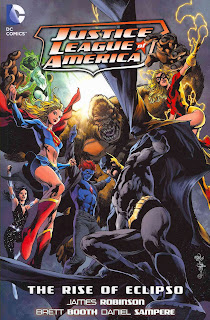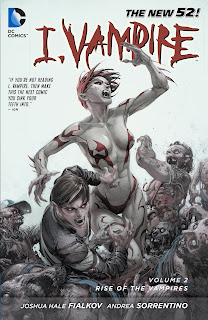 Once upon a time, DC Comics superheroes wore their collars low and their underwear on the outside, and the Justice League consisted of second-generation heroes including Batman Dick Grayson, Donna Troy, Supergirl, and others. With focus shifted to the New 52, DC cancelled the hardcover of James Robinson’s final collection of his League run, Justice League of America: The Rise of Eclipso, but the book emerged later in paperback amidst the first wave of New 52 collections, a veritable message in a bottle from another era, bobbing in a sea of change.
Once upon a time, DC Comics superheroes wore their collars low and their underwear on the outside, and the Justice League consisted of second-generation heroes including Batman Dick Grayson, Donna Troy, Supergirl, and others. With focus shifted to the New 52, DC cancelled the hardcover of James Robinson’s final collection of his League run, Justice League of America: The Rise of Eclipso, but the book emerged later in paperback amidst the first wave of New 52 collections, a veritable message in a bottle from another era, bobbing in a sea of change.Robinson’s story is enjoyable if madcap, as Robinson’s Justice League stories have tended to be — the action shifts back and forth in time, characters leave and return at random, the Leaguers call each other “babe” and “doll” and seem extraordinarily concerned with each others' emotional well-beings. That won’t be for everyone, but it’s clear Robinson likes and respects this team, and that the characters like one another — this League may be the closest to friends that I can recall — and that makes for a pleasant read especially when the team’s fate is decided in the last chapter.
[Review contains spoilers]
Justice League, like Bryan Miller’s Batgirl and indeed in many ways very similar to it, was a title that addressed the New 52 relaunch head-on in its closing pages. The team decides to disband, notably not because of any internal strife but simply because the team members have grown up and some have even been emotionally healed by their time with the League, and they’re ready for the next step in their lives. Dick and Donna speculate whether the world will remember their League; perhaps not, they think, but they agree at least that it’s been “a blast” serving together in the League.
Though the creation of this League was separate and unrelated to DC’s later decision to reboot their story universe, it does seem an appropriate League to end the post-Crisis on Infinite Earths Justice League on — indeed it’s hard to imagine the “old” Big Seven coming back after this League had filled their shoes. Former Robin Dick Grayson and Donna Troy, especially, are the original sidekicks, and to see them lead the Justice League and then, moreover, to leave it, seems inescapably the conclusion of the post-Crisis League’s story arc; this is even further compounded by having children of the Justice Society, Jade and Jessie Quick, present as well.
What may be most controversial in the conclusion is Donna's statement, via Robinson, that she herself hopes to be forgotten by the world (and by implication, the reader), though her wish makes perfect sense in terms of how Robinson has, smartly, portrayed Donna -- what may be the most honest portrayal of Donna Troy so far. Donna is a character considerably buffeted by the whims of creators — married, divorced, mystically pregnant, killed and resurrected, with multiple origins, and not only did her son die, but she later had to kill her son’s zombie corpse. The capriciousness with which creators have treated this character (specifically, this female character, while her male counterparts escape similar fates) ought offend the reader, and in his four Justice League volumes Robinson has channeled that offense into Donna’s new, considerable anger — she herself is angry at how the “universe” has treated her, and she struggles to control or surmount that anger.
It is a little easy, but then again necessary given Robinson’s foreshortened run, that it turns out that all the pain Donna has undergone has purified her soul such to allow her to defeat the villain du jour, Eclipso. With that success, Donna feels her anger has left her, and she decides to retire to a normal life, hoping, again, that her superhero days will be forgotten. Given the greater lows than highs of Donna’s adventures, I see Robinson’s point and I’m inclined to agree with him — perhaps the best thing for Donna would be to see her left alone, rather than brought back in the New 52 and subjected, invariably, to more shenanigans. More likely, however, Robinson probably gets it right when he has Dick Grayson, foreshadowing the Wally West/Stephanie Brown wars to come, grin at the camera and says, “I can guarantee not everyone is going to forget you.”
The other seven issues of Justice League collected here (plus, for good measure, one issue Robinson wrote of Justice Society) are, again, enjoyable, though the Eclipso story itself differs not that much from Eclipso stories past, despite Eclipso’s constant espousing that he’s committing his mayhem differently this time — though still on the moon, and still with a bevy of eclipsed heroes (where is my Eclipso: The Darkness Within omnibus, anyway?).
What does differentiate the story, however, are some of the philosophical knots that Robinson, through Eclipso and his alter-ego Bruce Gordon, ties himself in — how Eclipso believes his previous plots against Earth my have been inspired in him by God such to guarantee Eclipso’s defeat, and now by working against his own impulses he may be able to supersede that “determinism” and kill God himself; or how Eclipso identifies Earth as God’s device to channel faith out into the universe, and by disrupting the moon and therefore the water in people’s bodies, Eclipso can “break faith,” essentially, and kill God. It’s weird, heady stuff, but the fact that it’s heady is more than made up for by the fact that it’s also not superhero comics as usual, and that’s a good thing.
In all I found the preceding volume, Justice League: Omega, more focused and less predictable than Justice League: Rise of Eclipso, but Robinson’s erstwhile Justice League is still a joy to read. To be sure, Robinson has defined Congorilla’s voice for a generation, and it’s nice to have him write Starman Mikaal Tomas — any chance DC might take Robinson’s Starman and sew it more or less whole cloth to the fabric of his New 52 Earth 2 series? It’s unlikely, but we can hope.
[Includes original and variant covers]
Someone say Earth 2? We continue our James Robinson spotlight week with a review of Earth 2: The Gathering, coming up.




























































